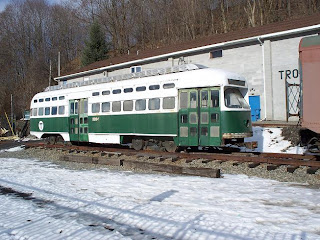As mentioned before, we want to replace all of the trolley shoe hardware with new parts that will be more reliable and easier to maintain, such as we use on the North Shore cars.
 We started by removing the old trolley casting from one of the 308's poles - I should have taken a picture of the original casting to show how worn out it was. Here I was helped by Warren Lloyd and Jerry. Here's the top end of the pole. You may be able to see how the end of the pole is tapered to be narrower so the casting will fit over it.
We started by removing the old trolley casting from one of the 308's poles - I should have taken a picture of the original casting to show how worn out it was. Here I was helped by Warren Lloyd and Jerry. Here's the top end of the pole. You may be able to see how the end of the pole is tapered to be narrower so the casting will fit over it. The bottom end of the pole was rusted and broken. As suggested by Bob Heinlein, I checked the length of the other poles on the 308 and 309. This pole from the 308 turned out to be 7 1/2" too short - evidently it had already been amputated at least once. So we needed to patch in a new piece. I cut off the bottom 6 1/2" of the pole.
The bottom end of the pole was rusted and broken. As suggested by Bob Heinlein, I checked the length of the other poles on the 308 and 309. This pole from the 308 turned out to be 7 1/2" too short - evidently it had already been amputated at least once. So we needed to patch in a new piece. I cut off the bottom 6 1/2" of the pole. I then cut off a 14" length of spare pole material. In order to weld it onto the old pole, we needed a length of pipe as a stiffener. 1" ID pipe was slightly too big, so Rod turned it down on the lathe.
I then cut off a 14" length of spare pole material. In order to weld it onto the old pole, we needed a length of pipe as a stiffener. 1" ID pipe was slightly too big, so Rod turned it down on the lathe. Then he polished and beveled the ends, as seen here.
Then he polished and beveled the ends, as seen here. Then we took the parts out to the mig welder, and Rod welded them together. The batteries for his automatic adjusting welding helmet had died, so I had to run to the hardware store in Marengo to get some new ones. The welding then went quickly.
Then we took the parts out to the mig welder, and Rod welded them together. The batteries for his automatic adjusting welding helmet had died, so I had to run to the hardware store in Marengo to get some new ones. The welding then went quickly. After grinding it down, the patch looks like this. The weld is just perfect.
After grinding it down, the patch looks like this. The weld is just perfect.







































